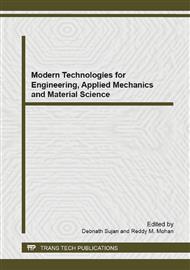[1]
C.C. Foo, L.K. Seah, G.B. Chai, Low-velocity impact failure of aluminium honeycomb sandwich panels, Composite Structures. 85(1) (2008) 20-28.
DOI: 10.1016/j.compstruct.2007.10.016
Google Scholar
[2]
V. Crupi, G. Epasto, E. Guglielmino, Collapse modes in aluminium honeycomb sandwich panels under bending and impact loading, International Journal of Impact Engineering. 43 (2012) 6-15.
DOI: 10.1016/j.ijimpeng.2011.12.002
Google Scholar
[3]
L. Aktay, A.F. Johnson, M. Holzapfel, Prediction of impact damage on sandwich composite panels, Computational Materials Science. 32(3-4) (2005) 252-260.
DOI: 10.1016/j.commatsci.2004.09.044
Google Scholar
[4]
K.W. Jeon, K.B. Shin, An experimental investigation on low-velocity impact responses of sandwich panels with the changes of impact location and the wall partition angle of honeycomb core, International Journal of Precision Engineering and Manufacturing. 13(10) (2012).
DOI: 10.1007/s12541-012-0235-8
Google Scholar
[5]
R.C. Moody, A.J. Vizzini, Test and analysis of composite sandwich panels with impact damage, In: U.S. Federal Aviation Administration, Office of Aviation Research, Washington, 2002, p.6.
Google Scholar
[6]
T.E. Plam, Impact resistance and residual compression strength of composite sandwich panels, In: Proc 8th bat Conf on Composite Mat. (ICCM/8), Honolulu, 1991, pp.1-13.
Google Scholar
[7]
T. Gottesman, Criticality of impact damage in composite sandwich structures, In: Proc of 6th lnt Conf on Comp Mat Combined with the 2nd European Conf on Comp Mat, London, 1987, p.3. 27-3. 35.
Google Scholar
[8]
J.S. Tomblin, Impact damage characterization and damage tolerance of composite sandwich airframe structures - Phase II, In: U.S. Federal Aviation Administration, Office of Aviation Research, Washington, 2002, pp.4-6.
Google Scholar
[9]
K. Azouaoui, Z. Azari, G. Pluvinage, Evaluation of impact fatigue damage in glass/epoxy composite laminate, International Journal of Fatigue. 32(2) (2010) 443-452.
DOI: 10.1016/j.ijfatigue.2009.09.005
Google Scholar
[10]
X.L. Fan, T.J. Wang, Q. Sun, Damage evolution of sandwich composite structure using a progressive failure analysis methodology, Procedia Engineering. 10 (2011) 530-535.
DOI: 10.1016/j.proeng.2011.04.089
Google Scholar


